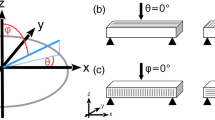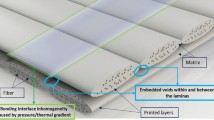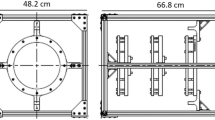Abstract
This effort describes experiments for the validation of the response of an additively manufactured stiffness-optimized short-fiber reinforced composite. A Direct Ink Write (DIW) method is used to additively manufacture a clevis joint plate which was designed such that its compliance would be minimized (i.e., stiffness maximized) for far-field axial loading. A unique aspect of the optimization scheme is that it accounts for manufacturing constraints, such as tool turn radius and tool path spacing. Along with the optimized clevis joint plate, additively manufactured 0°–90° and ± 45° composite plates of the same number of layers, as well as a control 0°–90° sample of resin only, were also studied. In addition to far-field load-displacement, near-field strain was monitored using digital image correlation (DIC). The results showed that the optimized plate did indeed exhibit the largest stiffness, based on far-field measurements. DIC-measured strains showed that locally the axial strain component, which is the largest, was also minimized for the optimized specimen, although the other strain components followed different trends. Furthermore, in the experiments it was seen that the optimized design exhibited a nonlinear/hysteretic behavior which is believed to be a consequence of its internal gap/cell structure. This internal structure, which results by optimized placement of material, although explicitly not accounted for in the optimization, may affect global response. Finally, although not a part of the optimization study itself, the failure load for the optimized joint plate was also seen to be the largest of all the cases studied.












Similar content being viewed by others
References
Gibson I, Rosen D, Stucker B (2015) Additive manufacturing technologies: 3D printing, rapid prototyping, and direct digital manufacturing, 2nd edn. Springer, New York. https://doi.org/10.1007/978-1-4939-2113-3
Lewicki JP, Rodriguez JN, Zhu C, Worsley MA, Wu AS, Kanarska Y, Horn JD, Duoss EB, Ortega JM, Elmer W, Hensleigh R, Fellini RA, King MJ (2017) 3D-printing of Meso-structurally ordered carbon fiber/polymer composites with unprecedented orthotropic physical properties. Sci Rep 7:43401. https://doi.org/10.1038/srep43401
Ghiasi H, Fayazbakhsh K, Pasini D, Lessard L (2009) Optimum stacking sequence design of composite materials part I: constant stiffness design. Compos Struct 90:1–11
Ghiasi H, Fayazbakhsh K, Pasini D, Lessard L (2010) Optimum stacking sequence design of composite materials part II: variable stiffness design. Compos Struct 93(1):1–13
Lozano GG, Tiwari A, Turner C, Astwood S (2016) A review on design for manufacture of variable stiffness composite laminates. Proc Inst Mech Eng B J Eng Manuf 230(6):981–992
Fernandez F, Compel WS, Lewicki JP, Tortorelli DA (2018) Optimal design of fiber reinforced composite structures and their direct ink writing fabrication. Accepted Computer Methods in Applied Mechanics and Engineering
Chou T-W (1992) Microstructural design of fiber composites, Cambridge University Press, Ch. 4, p 203
Halpin JC (1969) Stiffness and expansion estimates for oriented short fiber composites. J Compos Mater 3(4):732–734
Halpin JC, Kardos JL (1976) The Halpin-Tsai equations: a review. Polym Eng Sci 16(5):344–352
Tucker CL III, Liang E (1999) Stiffness predictions for unidirectional short-fiber composites: review and evaluation. Compos Sci Technol 59(5):655–671
Sutton MA, Orteu J-J, Schreier HW (2009) Image correlation for shape, motion and deformation measurements, chapter 6: in-plane measurements. Springer Science and Business Media, LLC, New York. https://doi.org/10.1007/978-0-387-78747-3_6
Acknowledgments
This work was partially performed under the auspices of the U.S. Department of Energy by Lawrence Livermore National Laboratory under contract DE-AC52-07NA27344, with Funding from LDRD 15-ERD-030 and LLNLCONF-717640. Document Number: LLNL-JRNL-764135-DRAFT.
Author information
Authors and Affiliations
Corresponding author
Additional information
Publisher’s Note
Springer Nature remains neutral with regard to jurisdictional claims in published maps and institutional affiliations.
Rights and permissions
About this article
Cite this article
Saito, Y., Fernandez, F., Tortorelli, D. et al. Experimental Validation of an Additively Manufactured Stiffness-Optimized Short-Fiber Reinforced Composite Clevis Joint. Exp Mech 59, 859–869 (2019). https://doi.org/10.1007/s11340-019-00514-2
Received:
Accepted:
Published:
Issue Date:
DOI: https://doi.org/10.1007/s11340-019-00514-2




